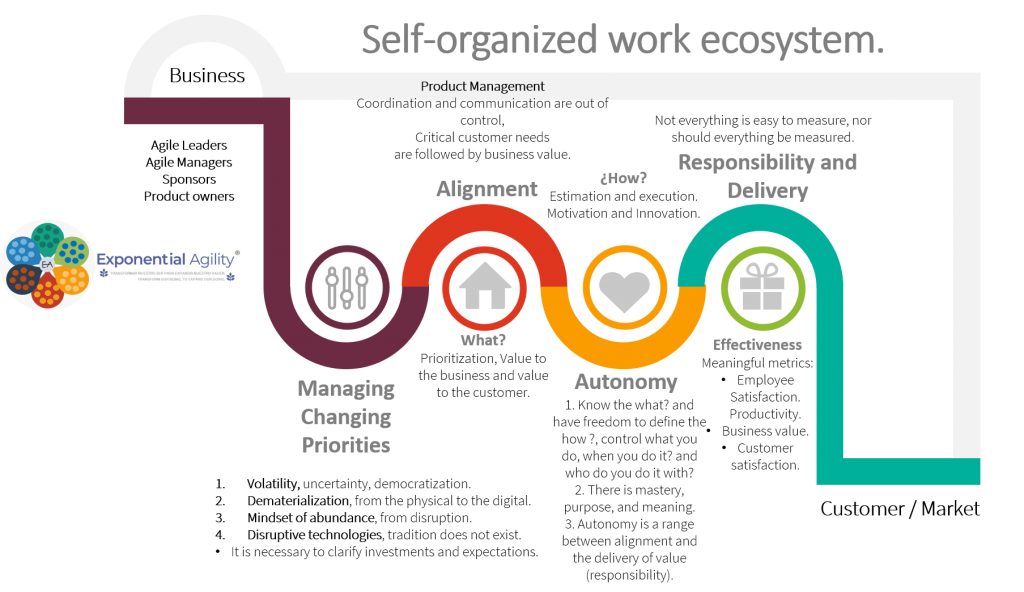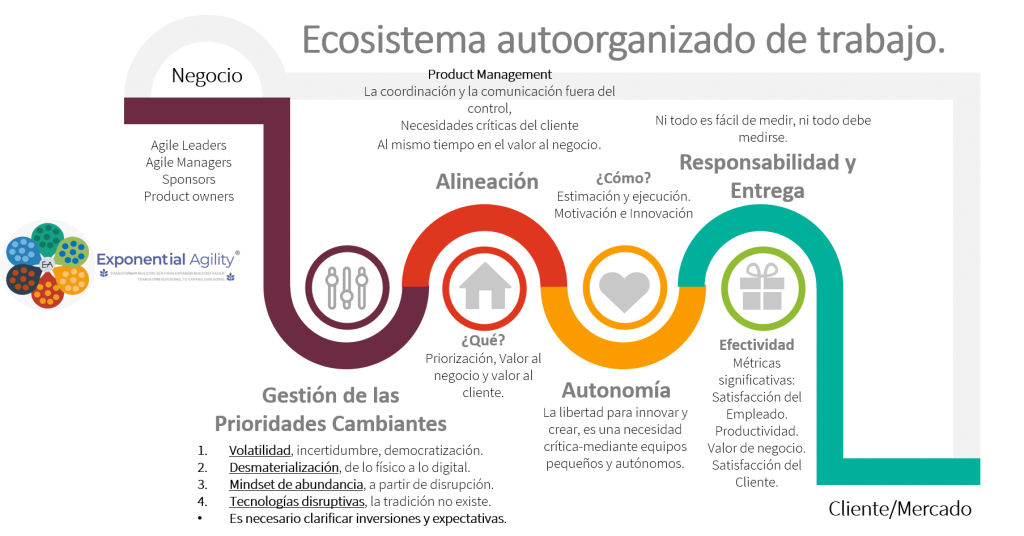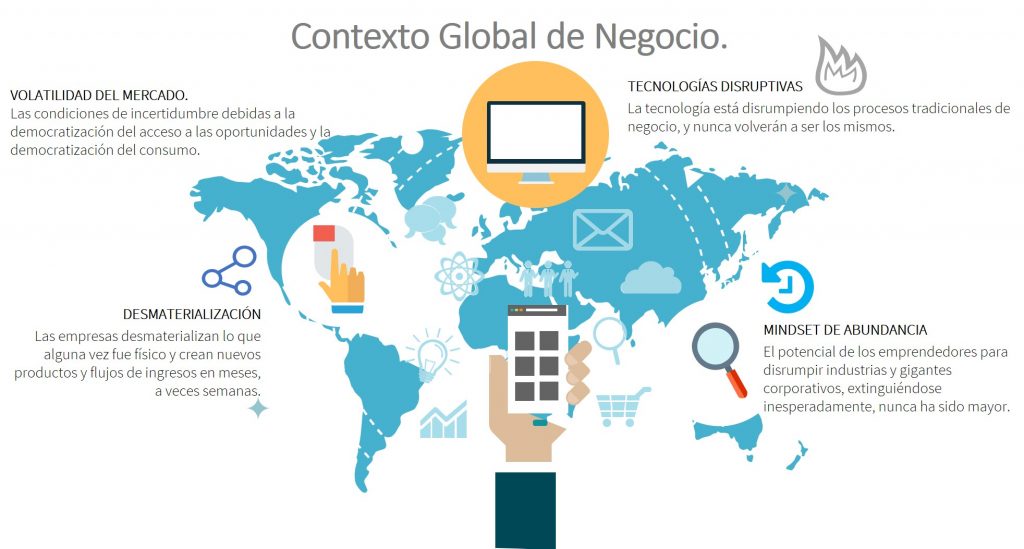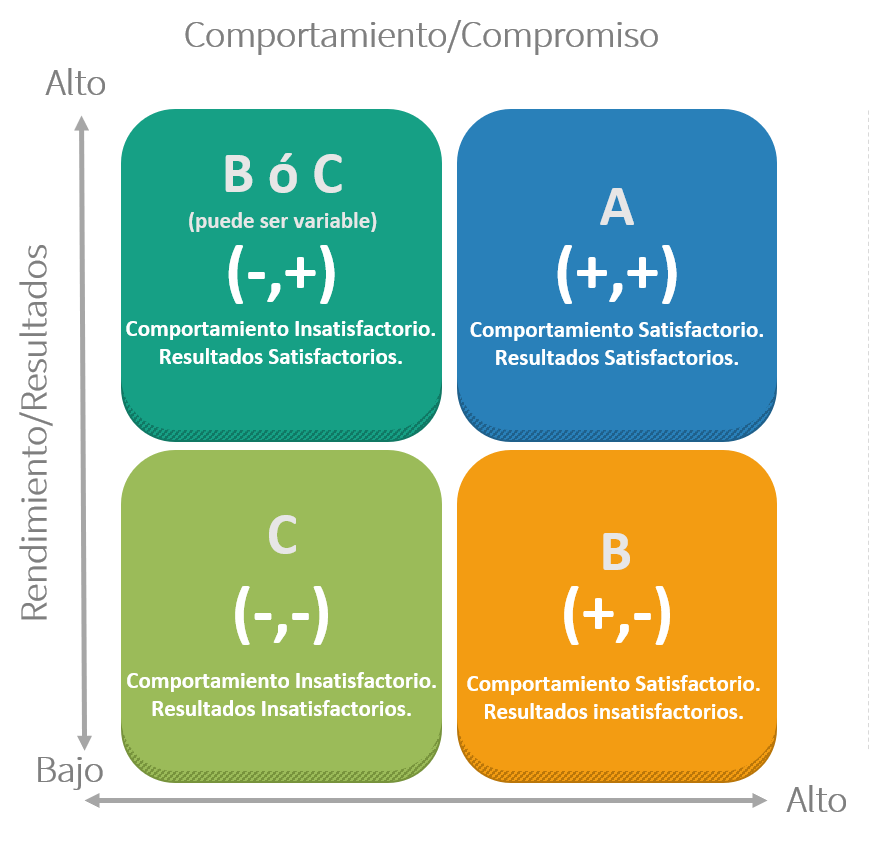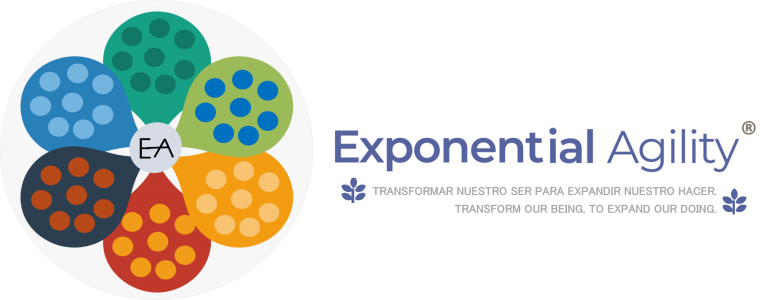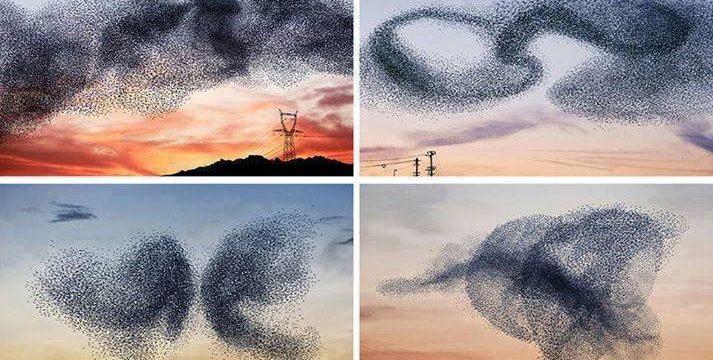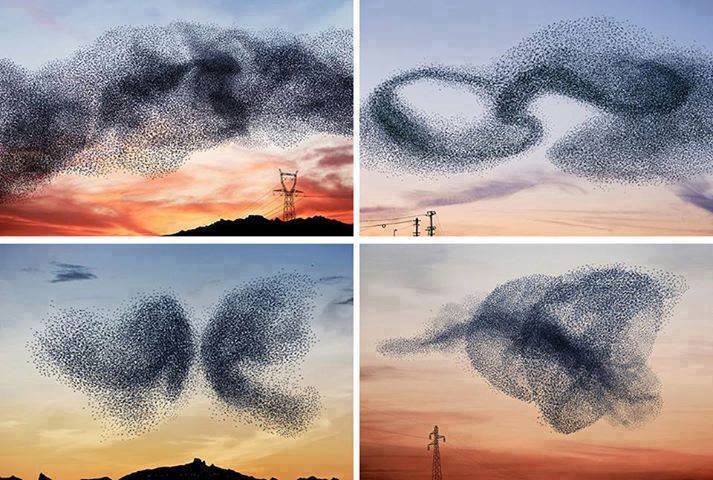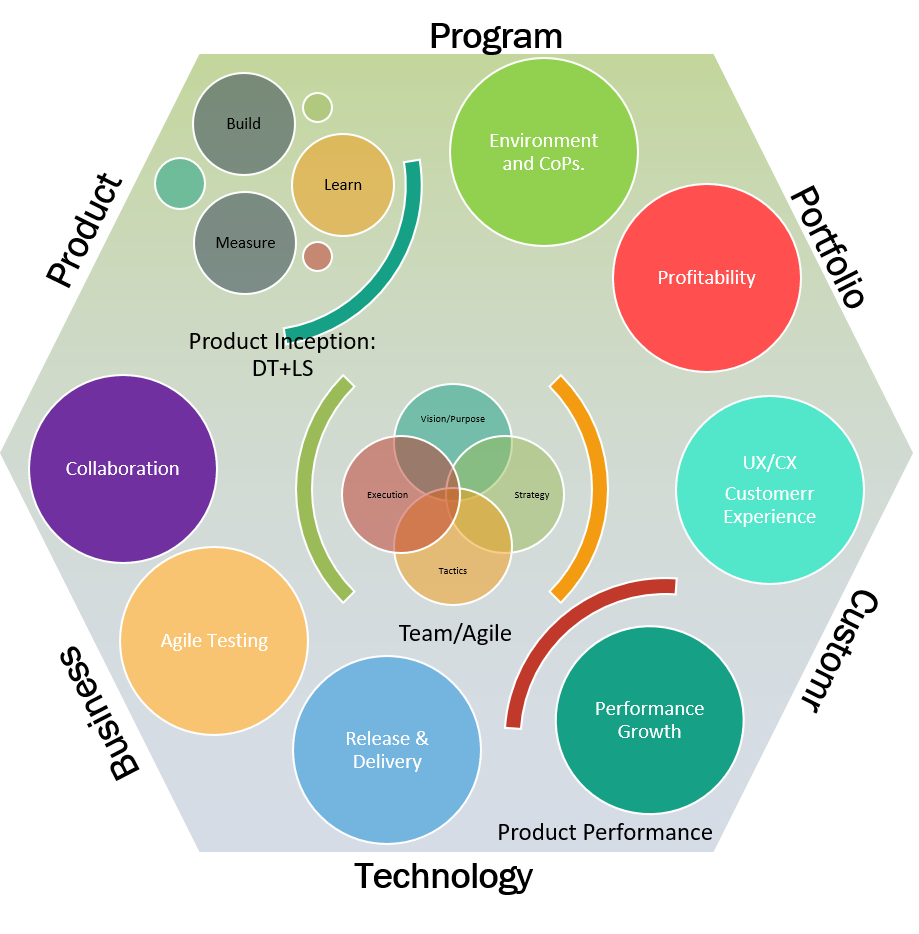Elements of a high-performance self-organizing work ecosystem.

Figure 01: Elements of a self-organized ecosystem.
In this article we will continue with the development of the topic of self-organization, a very exciting topic, the idea is that we go from the abstract to the concrete and build it in an iterative, incremental and emergent way, all based on practice, in our experience on the dance floor (which is not the only one), we have put this model into practice in about 5 agile transformations, with very good results, if you require more detail, do not hesitate to contact us.
Remember that when we talk about self-organization, we must keep in mind:
- Internal regulation, is represented by basic rules, outside of control and centralization.
- These rules are created from positive feedback from the interaction of the elements.
- Their strength lies in creating and maintaining new behaviors or creating new contexts and their respective behaviors.
- Self-organization is to choreography, like orchestration is to command and control.
Jack Welch, described a very interesting work model in which he defines collaborator archetypes, although one size does not have to fit all, it is useful to highlight the diversity of the topic and at least highlight 3 types of players in agreement to two basic variables, which are: performance / results and commitment / behavior.
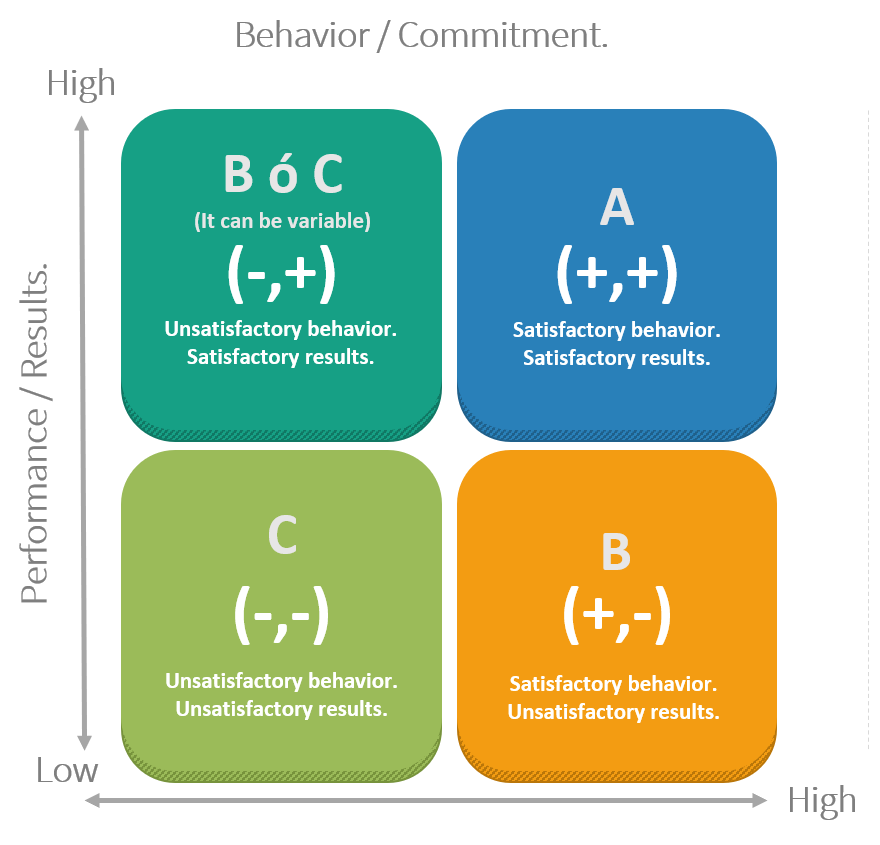
Figure 02: Performance and commitment matrix. Based on Jack Welch (2).
(+, +)
These collaborators are an example to others and fit perfectly with the vision and way of working of the organization. Behavior is positive and strengthens the motivations of others, and performance and results are good to excellent. It is the place where players A live.
(-, +)
His/her behavior score was insufficient. If the behavior is slightly deviant or undesirable, it can be improved and trained. If the behavior is completely unacceptable or negatively impacts others. It is an excellent area for C players, although there are also B.
(+, -)
In this case, the results are insufficient. Results may differ slightly from expectations, in which case improvement is still possible. If the results are definitely insufficient, a transfer can be considered. The work scheme can be reinforced through coaching, training, mentoring and facilitation. Players B place, for this it is necessary to develop them. Some hidden C players may live here.
(-, -)
This group of collaborators failed to obtain a passing grade on both criteria. This group of collaborators does not offer good results, and their inappropriate behavior has a negative influence on the rest of the employees. Players’ ideal zone C.
To enable an agile company, we must find those agile champions, players A and B, who have high commitment and performance. Players B, who through coaching, training, commitment and mentoring can develop to become those players A.
Self-organization metaphor.
Traditional companies are based on orchestration, which is why it is necessary to modify the organization’s operating system, creating a metabolism that censors and responds effectively to the market. This involves transitioning to a new focus. A metaphor that defines the type of company we want to have is that of a three-story building.
- Basement, is based on anarchy or excessive authority. No one wants to work in a place where they are watched 24 hours a day, where everyone wants to be the orchestrators and wants to control your work, nor does anyone want to work in a place where there is eternal anarchy, and everything is a magical ether in the air, without compromise , without responsibility and without results. Players B and C live here, it’s a place full of technical debt, players A cannot enter, they are prohibited from this floor.
- Floor, in this space there is no empowerment, no commitment, a collaborator contribute with the minimum necessary. The managers’ commitment is minimal: “I don’t want to know what that means, for others to do it: if it doesn’t work, we’ll see what steps we take, everyone leaves, they have only two months.” Players C manage, value and hire staff here, some Players B and few A.
- Roof, there is mastery, purpose and meaning of work. (A +, C +) players A and B. There is commitment on the part of everyone involved and team leaders and managers, that commitment is transmitted to everyone, team members learn by example, they want to know more, they want being better at what they do motivates them a lot to know what is the positive impact of why they do what they do, they breathe and live an atmosphere of fun, alignment, learning, autonomy, transparency and results.
For the sustained existence of the mentioned criteria, it is necessary that the environment has the following 3 elements (beyond technical or cultural debt, operational excellence, which also needs to be managed):
1) Alignment, 2) autonomy, 3) transparency and delivery of results.
Alignment:
- It consists of determining what? the priorities, the definition of value.
- Know the capabilities of the teams.
- Commitment – business and product owners for required capabilities.
- Socialize all these elements.
Autonomy:
- It consists of knowing the what? and have freedom to define the how?
- There is mastery, purpose, and meaning.
- It involves autonomous control of what you do, when you do it and with whom you do it.
- Range between alignment and value delivery.
Results:
- It consists of creating effectiveness of the how? Delivering value.
- Not everything is easy to measure, and not everything must be measured.
- We learn quickly by experimenting in a disciplined way and that is an advantage.
To reinforce this self-organized work scheme based on high motivation and high performance, it is necessary that we always keep in mind these elements that are associated with Autonomy:
1) Mastery, involves constantly improving your skills and competences through learning and practice.
For example: A test pilot may be motivated by the riskiness of the maneuvers she executes breaking her own limits, surely, any recognition she receives is less important than her continuous improvement process.
2) Purpose: The most productive and committed people are those who truly believe that the impact of what they do is greater and more important than themselves.
Connecting the personal objectives of our collaborators with the organizational objectives can create winners not only in your mind, but in your heart.
3) Meaning: We have 3 members of a team that create digital accounts for newly started entrepreneurs, all three are asked the same question, what are you doing ?:
Member 1) Layout and code web pages.
Member 2) We register business accounts.
Member 3) We focus on achieving a life goal, granting opportunities, through a satisfactory, agile and expeditious digital experience.
The third member of the team has a well defined purpose and meaning of why it is there.
In our next article, we will build this approach in a hands-on way and land it the way our teams create and operate, to create and deliver value.
Miguel Martínez, August 5, 2020.
Bibliography:
- Avery, Christopher M., et al. Teamworking Is an Individual Skill: Getting Your Work Done When Sharing Responsibility. Berrett-Koehler, 2001.
- Janse, Ben. “What Is the Jack Welch Matrix? Explanation, Strategies + Tips.” Toolshero, 16 July 2020, www.toolshero.com/human-resources-hr/jack-welch-matrix/.
- Pink, Daniel H. Drive the Surprising Truth about What Motivates Us. Riverhead Books, 2009.
- Wiseman, Liz, and Stephen R. Covey. Multipliers: How the Best Leaders Make Everyone Smarter. HarperBusiness, an Imprint of HarperCollinsPublishers, 2017.
- Wojcicki, Esther. How to Raise Successful People: Simple Lessons for Radical Results. Houghton Mifflin Harcourt, 2019.


